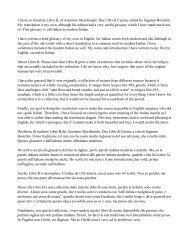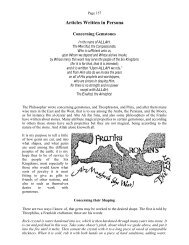How to Milk an Almond Stuff an Egg And Armor a Turnip A ...
How to Milk an Almond Stuff an Egg And Armor a Turnip A ...
How to Milk an Almond Stuff an Egg And Armor a Turnip A ...
You also want an ePaper? Increase the reach of your titles
YUMPU automatically turns print PDFs into web optimized ePapers that Google loves.
139<br />
Old World Foods<br />
Coffee<br />
The coffee pl<strong>an</strong>t is apparently native <strong>to</strong> Abyssinia. The use of coffee in Abyssinia was<br />
recorded in the fifteenth century <strong>an</strong>d regarded at that time as <strong>an</strong> <strong>an</strong>cient practice (EB). I believe<br />
that there is a reference in one of the Greek his<strong>to</strong>ri<strong>an</strong>s <strong>to</strong> what sounds like coffee being drunk in<br />
what might well be Abyssinia, but I have not yet succeeded in tracking it down.<br />
Coffee was apparently introduced in<strong>to</strong> Yemen from Abyssinia in the middle of the 15th<br />
century. It reached Mecca in the last decade of the century <strong>an</strong>d Cairo in the first decade of the<br />
16th century (Hat<strong>to</strong>x).<br />
The use of coffee in Egypt is mentioned by a Europe<strong>an</strong> resident near the end of the sixteenth<br />
century. It was brought <strong>to</strong> Italy in 1615 <strong>an</strong>d <strong>to</strong> Paris in 1647 (LG). The first coffee house in<br />
Engl<strong>an</strong>d was opened in Oxford in 1650 (Wilson), <strong>an</strong>d the first one in London in 1652 (EB). The<br />
earliest use of the word in English is in 1592, in a passage describing its use in Turkey (OED).<br />
It appears that coffee is out of period for Europe<strong>an</strong> feasts <strong>an</strong>d late period for Islamic ones.<br />
Tea<br />
The use of tea in China <strong>an</strong>d Ceylon goes back <strong>to</strong> prehis<strong>to</strong>ric times. According <strong>to</strong> the Larousse,<br />
it was brought <strong>to</strong> Europe by the Dutch in 1610 <strong>an</strong>d <strong>to</strong> Engl<strong>an</strong>d in 1644. According <strong>to</strong> the OED, it<br />
was first imported in<strong>to</strong> Europe in the 17th century <strong>an</strong>d first mentioned in a Europe<strong>an</strong> l<strong>an</strong>guage<br />
(Portuguese) in 1559. The first use of the word in English (in the form “Cha”) is given as 1598;<br />
the passage seems <strong>to</strong> describe its use in China.<br />
It appears that tea is out of period for Europe<strong>an</strong> feasts <strong>an</strong>d (since it was being brought from<br />
China by sea rather th<strong>an</strong> overl<strong>an</strong>d) even further out of period for Islamic feasts. It is, of course, in<br />
period for Chinese <strong>an</strong>d Jap<strong>an</strong>ese feasts. So far as I know, iced tea is a modern invention.<br />
B<strong>an</strong><strong>an</strong>as<br />
The Four Seasons of the House of Cerruti, <strong>an</strong> Itali<strong>an</strong> m<strong>an</strong>uscript of the fourteenth century<br />
(based on <strong>an</strong> Arab work of the eleventh century) mentions b<strong>an</strong><strong>an</strong>as as something which “we<br />
know of .. only from texts or tales from merch<strong>an</strong>ts from Cyprus or pilgrims from the Holy L<strong>an</strong>d.<br />
Sicili<strong>an</strong>s ... know them well.” It is clear from the accomp<strong>an</strong>ying picture that the artist had never<br />
seen a b<strong>an</strong><strong>an</strong>a. The first bunch of b<strong>an</strong><strong>an</strong>as is said <strong>to</strong> have reached Engl<strong>an</strong>d in 1633 (Wilson).<br />
Citrus Fruit<br />
Citrus fruit are native <strong>to</strong> southern Asia <strong>an</strong>d the Malay Archipelago, <strong>an</strong>d cultivated citrus occur<br />
very early in China. In the West, the citron was known <strong>to</strong> classical <strong>an</strong>tiquity. By the 10 th c. the<br />
Arabs had sour or<strong>an</strong>ges, <strong>an</strong>d by the 12 th century lemon, sour or<strong>an</strong>ge, citron, <strong>an</strong>d pummelo had all<br />
made it as far as Spain <strong>an</strong>d North Africa. By the 13 th century lemon, sour or<strong>an</strong>ge, citron, <strong>an</strong>d what<br />
is probably lime are described from northern Italy. The sweet or<strong>an</strong>ge is mentioned in a few<br />
documents from the second half of the 15 th century as growing in Italy <strong>an</strong>d southern Fr<strong>an</strong>ce, <strong>an</strong>d<br />
seems <strong>to</strong> have been fairly widely grown by the early 16 th century. In 1520 or thereabouts the<br />
Portuguese brought a new <strong>an</strong>d superior sweet or<strong>an</strong>ge variety from China, which then spread<br />
around the citrus-growing areas of Europe in the 16 th <strong>an</strong>d 17 th centuries. M<strong>an</strong>darin or<strong>an</strong>ges do not<br />
seem <strong>to</strong> have made it <strong>to</strong> Europe until the early 19 th century. The grapefruit seems <strong>to</strong> have





